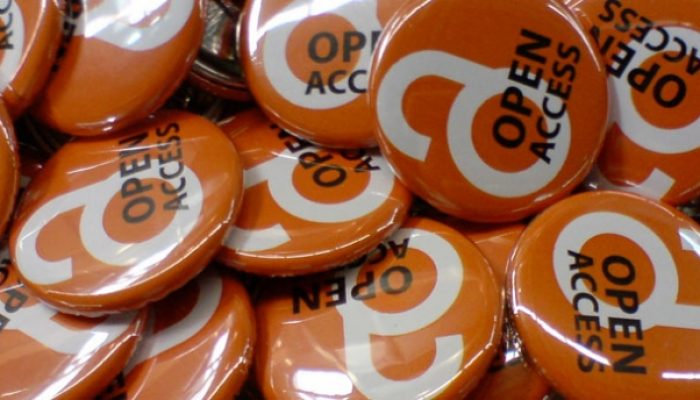Open access publishing has become common practice in the science community. In this guest post, David Fernández-Blanco, a contributor to the EGU Tectonics and Structural Geology Division blog, presents one facet of open access that is changing the publishing system for many geoscientists: preprints.
Open access initiatives confronting the publishing system
The idea of open access publishing and freely sharing research outputs is becoming widely embraced by the scientific community. The limitations of traditional publishing practices and the misuse of this system are some of the key drivers behind the rise of open access initiatives. Additionally, the open access movement has been pushed even further by current online capacities to widely share research as it is produced.

Credit: Academia Obscura
Efforts to make open access the norm in publishing have been active for quite some time now. For example, almost two decades ago, the European Geosciences Union (EGU) launched its first open access journals, which hold research papers open for interactive online discussion. The EGU also allows manuscripts to be reviewed online by anyone in the community, before finally published in their peer-reviewed journals.
This trend is also now starting to be reflected at an institutional level. For example, all publicly funded scientific papers in Europe could be free to access by 2020, thanks to a reform promoted in 2016 by Carlos Moedas, the European Union’s Commissioner for Research, Science and Innovation.
More recently, in late 2017, around 200 German universities and research organisations cancelled the renewal of their Elsevier subscriptions due to unmet demands for lower prices and an open access policies. Similarly, French institutions refused a new deal with Springer in early 2018. Now, Swedish researchers have followed suit, deciding to cancel their agreement with Elsevier. All these international initiatives are confronting an accustomed publishing system.
PUBLISH OR PERISH!!!! pic.twitter.com/a5333nDd4F
— Lego Academics (@LegoAcademics) August 8, 2014
The community-driven revolution
Within this context, it’s no surprise that the scientific community has come up with various exciting initiatives that promote open access, such as creating servers to share preprints. Preprints are scientific contributions ready to be shared with other scientists, but that are not yet (or are in the process of being) peer-reviewed. A preprint server is an online platform hosting preprints and making them freely available online.
Many journals that were slow to accept these servers are updating their policies to adapt to the steadily growing increase of preprint usage by a wide-range of scientific communities. Now most journals welcome manuscripts hosted by a preprint server. Even job postings and funding agencies are changing their policies. For example, the European Research Council (ERC) Starting and Consolidator Grants are now taking applicant preprints into consideration.
Preprints: changing the publishing system
ArXiv is the oldest and most established preprint server. It was created in 1991, initially directed towards physics research. The server receives on average 10,000 submissions per month and now hosts over one million manuscripts. Arxiv sets a precedent for preprints, and now servers covering other scientific fields have emerged, such as bioRxiv and ChemRxiv.

Credit: EarthArXiv
EarthArXiv was the first to fill the preprint gap for the Earth sciences. It was launched in October 2017 by Tom Narock, an assistant professor at Notre Dame of Maryland University in Baltimore (US), and Christopher Jackson, a professor at Imperial College London (UK). In the first 24 hours after its online launch, this preprint server already had nine submissions from geoscientists.
The server holds now more than 400 preprints, approved for publication after moderation, and gets around 1,600 downloads monthly. The platform’s policy may well contribute to its success – EarthArXiv is an independent preprint server strongly supported by the Earth sciences community, now run by 125 volunteers. The logo, for example, was a crowdsourcing effort. Through social media, EarthArXiv asked the online community to send their designs; then a poll was held to decide which one of the submitted logos would be selected. Additionally, the server’s Diversity Statement and Moderation Policy were both developed communally.

Credit: ESSOAr
In February 2018, some months after EarthArXiv went live, another platform serving the Earth sciences was born: the American Geophysical Union’s Earth and Space Science Open Archive, ESSOAr. The approach between both platforms is markedly different; ESSOAr is partially supported by Wiley, a publishing company, while EarthArXiv is independent of any publishers. The ESSOAr server is gaining momentum by hosting conference posters, while EarthArXiv plans to focus on preprint manuscripts, at least for the near future. The ESSOAr server hosts currently 120 posters and nine preprints.
What is the power of preprints?
How can researchers benefit from these new online sources?
No delays:
Preprint servers allow rapid dissemination. Through preprints, new scientific findings are shared directly with other scientists. The manuscript is immediately available after being uploaded, meaning it is searchable right away. There is no delay for peer-review, editorial decisions, or lengthy journal production.
Visibility:
A DOI is assigned to the work, so it is citable as soon as it is uploaded. This is especially helpful to early career scientists seeking for employment and funding opportunities, as they can show and prove their scholarly track record at any point.
Engagement:
Making research visible to the community can lead to helpful feedback and constructive, transparent discussions. Some servers and participating authors have promoted their preprints through social media, in many cases initiating productive conversations with fellow scientists. Hence, preprints promote not only healthy exchanges, but they may also lead to improvements to the initial manuscript. Also, through these exchanges, which occur outside of the journal-led peer-review route, it is possible to network and build collaborative links with fellow scientists.
Too many questions, looking forward to participating in HESS discussion! 🙂 The main question is: where are remaining 430 basins? is there any conspiracy?
— Georgy Ayzel (@hydrogo89) May 2, 2018
No boundaries:
Preprints allow everyone to have access to science, making knowledge available across boundaries.
The servers are open without cost to everyone forever. This also means tax payers have free access to the science they pay for.
Backup:
Preprint servers are a useful way to self-archive documents. Many preprint servers also host postprints, which are already published articles (after the embargo period applicable to some journals).
Given the difference between the publishing industry’s current model and preprint practices, it is not surprising to find an increasing number of scientists stirring the preprint movement. It is possible that many of such researchers are driven by a motivation to contribute to a transparent process and promote open science within their community and to the public. This motivation is indeed the true power of preprints.
Editor’s note: This is a guest blog post that expresses the opinion of its author, whose views may differ from those of the European Geosciences Union. We hope the post can serve to generate discussion and a civilised debate amongst our readers.





